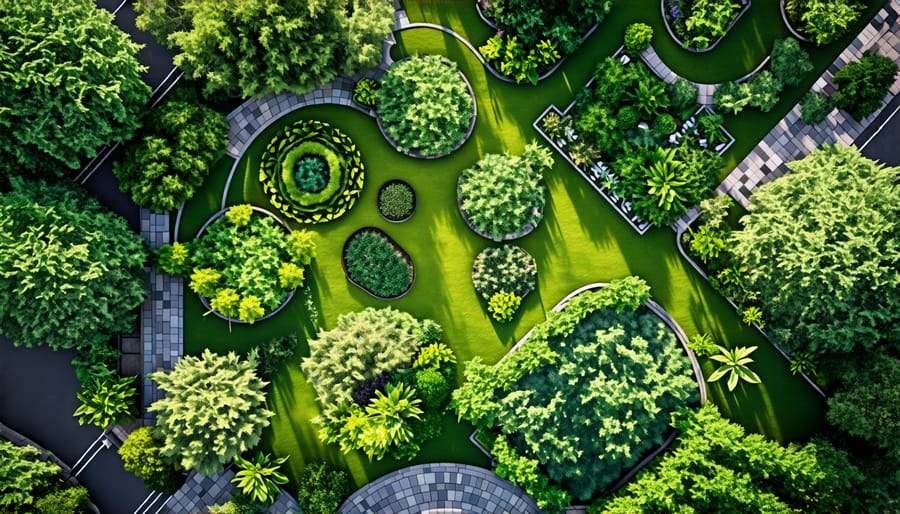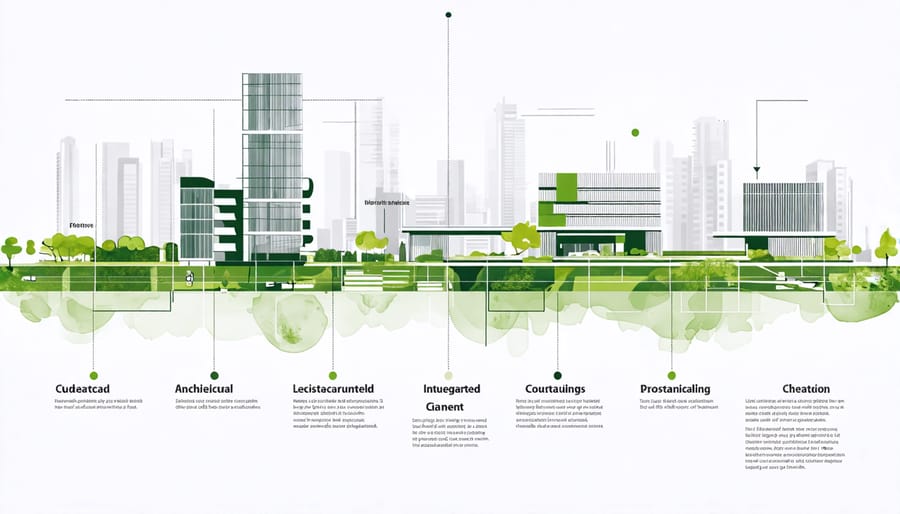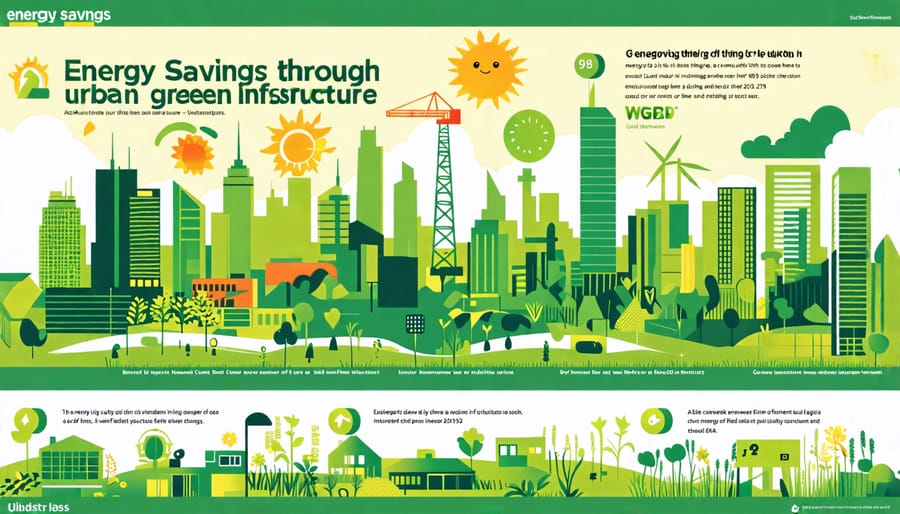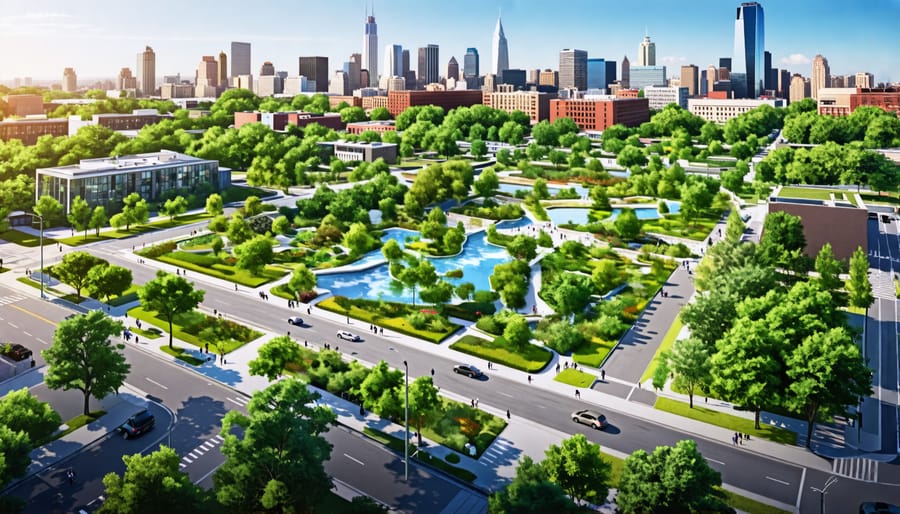Integrate permeable pavements to enhance stormwater management by allowing rainfall to infiltrate through surfaces, reducing runoff and improving water quality. Implement green roofs to absorb rainwater, provide insulation, and extend the lifespan of building materials while boosting urban biodiversity. Design rain gardens strategically to manage stormwater close to its source, filtering pollutants and facilitating ground absorption. Use urban tree canopies effectively for cooling urban areas, improving air quality, and creating aesthetically pleasing environments, which can translate into increased property values. Leverage bioswales to efficiently direct stormwater, enabling sediment and pollutant filtration, while supporting aesthetic and wildlife benefits in urban landscapes.
Defining Urban Green Infrastructure

Components of Urban Green Infrastructure
Urban green infrastructure comprises various components that seamlessly integrate nature into metropolitan settings, offering multiple benefits for construction professionals. Green roofs, a key element, transform rooftops into vegetated spaces that not only enhance aesthetic appeal but also improve thermal performance and stormwater management. Urban gardens, whether community-based or institutionally managed, provide social, environmental, and economic advantages by fostering biodiversity and promoting food security. Another critical aspect is the use of permeable pavements, which facilitate rainwater absorption, reducing runoff and mitigating urban flooding. Streetscapes, enhanced with tree canopies, provide shade, improve air quality, and contribute to the ecological connectivity within urban networks. Vertical gardens offer innovative solutions, maximizing green space in dense environments and improving building insulation. Additionally, urban wetlands and retention basins play a pivotal role in natural water filtration and habitat creation. These components, when strategically implemented, yield sustainable and resilient urban environments, aligning with contemporary urban development goals.
Environmental and Economic Benefits
Urban green infrastructure offers significant environmental and economic benefits, contributing to sustainability while enhancing cost-efficiency. By integrating natural elements like green roofs and permeable pavements, cities can reduce urban heat, manage stormwater, and improve air quality. These solutions lower energy demands by insulating buildings and mitigating heat islands, leading to reduced utility costs. Moreover, they enhance property values and support energy-efficient careers, driving economic growth within the construction sector. Through expert implementation and maintenance, urban green infrastructure provides long-term savings, aligns with sustainable development goals, and fosters resilient urban environments for future generations.
Innovative Designs and Architecture
Sustainable Architecture Trends
Sustainable architecture is increasingly integrating urban green infrastructure, reflecting a shift towards eco-friendly and energy-efficient design. Among the prevailing trends is the adoption of green roofs and living walls, which provide insulation, manage stormwater, and offer urban biodiversity habitats. Architects and engineers are leveraging cross-disciplinary collaborations to incorporate these elements effectively, aligning environmental goals with functional design.
In addition, the concept of biophilic design is gaining traction, emphasizing the integration of natural elements within urban spaces to improve occupant well-being and productivity. This includes the strategic use of daylighting, natural ventilation, and indoor greenery, all contributing to a healthier built environment.
Moreover, the trend of using sustainable materials, such as reclaimed wood and recycled concrete, is becoming prevalent. These materials not only reduce the carbon footprint but also offer longevity and resilience to structures. As green infrastructure continues to evolve, it presents opportunities for innovative, sustainable urban development, making it a critical consideration for construction professionals aiming to meet global sustainability standards.

Case Study: A Successful Green Project
In recent years, the city of Melbourne has emerged as a model for successful urban green infrastructure implementation. One standout project is the revitalization of Lincoln Square, where a collaborative effort between local authorities, landscape architects, and engineers transformed the area into a sustainable urban oasis. This project exemplifies the benefits of integrating green elements into urban settings, offering insights into practical application for industry professionals. Expert interviews reveal that strategic use of permeable pavements and native vegetation have not only enhanced aesthetic value but also improved stormwater management. The design includes innovative elements such as rain gardens and green roofs, which contribute to biodiversity while mitigating the urban heat island effect. Melbourne’s initiative demonstrates a scalable model that construction professionals and city planners can implement globally, showcasing how thoughtful design can yield environmental and social benefits. As cities grapple with climate challenges, projects like Lincoln Square highlight the critical role of green infrastructure in sustainable urban development.
Energy Efficiency and Urban Green Infrastructure

Reducing Energy Consumption
Urban green infrastructure plays a pivotal role in reducing energy consumption by incorporating nature-based solutions into the built environment. Techniques such as green roofs and walls enhance building insulation, leading to a decrease in heating and cooling demands. For example, green roofs can reduce indoor temperatures in summer, significantly cutting the need for air conditioning. Moreover, urban trees and vegetation offer natural shading and cooling through evapotranspiration, further decreasing the reliance on artificial cooling systems. In the context of urban planning, thoughtfully integrating green spaces contributes to the urban heat island effect reduction, directly impacting energy use across entire districts.
Studies also highlight that strategic placement of vegetation can lead to energy savings of up to 25% in buildings. By offering localized temperature regulation, they enable more efficient energy use in both residential and commercial spaces. For construction professionals, choosing suitable plant species and designing effective green spaces require collaboration with ecologists and energy experts. Ultimately, the adoption of green infrastructure not only fosters sustainability but also drives cost-effective energy management solutions in urban landscapes.
Innovations in Energy Management
Innovations in energy management are playing a pivotal role in enhancing the efficiency of urban green infrastructure, offering transformative benefits for city landscapes. Advanced technologies such as smart grids, IoT sensors, and data analytics are now being integrated with green building systems to optimize energy use and sustainability. Smart grids leverage real-time data to balance energy supply and demand, thereby reducing wastage and promoting renewable sources. Meanwhile, IoT sensors provide valuable insights into energy consumption patterns, enabling construction professionals to make informed decisions and improve efficiency.
Furthermore, architects and engineers are increasingly adopting energy-efficient materials and design strategies that complement green infrastructure. For instance, photovoltaic cells are being embedded into green roofs and facades to harness solar energy while providing insulation and reducing urban heat. Combined with advancements in energy storage solutions, these technologies contribute to a resilient, sustainable urban environment. Case studies from cities globally demonstrate the significant impact of these innovations, underscoring the potential for widespread adoption in future urban development projects.
Challenges and Solutions
Common Challenges
Implementing urban green infrastructure often presents several challenges. Construction professionals frequently encounter logistical issues, such as limited space in densely built environments, which complicate the integration of green spaces within urban settings. Budget constraints also pose a significant barrier, as the initial investment for green infrastructure can be high, and its benefits are often realized in the long term. Furthermore, there may be regulatory hurdles and a lack of standardized guidelines, leading to inconsistent implementation practices across projects. Additionally, maintaining green infrastructure requires specialized knowledge and skills, which might not be widely available, adding another layer of complexity to its adoption.
Proposed Solutions
To address the challenges in developing and maintaining urban green infrastructure, strategic planning and innovative design are paramount. Integrating green spaces with existing urban landscapes requires a collaborative approach between architects, engineers, and urban planners. Utilizing modular systems and lightweight materials can help retrofit green infrastructure onto existing structures without compromising structural integrity. Water management strategies such as rain gardens and permeable pavements are essential for dealing with the increased urban flooding and reducing the strain on sewer systems. The use of native vegetation in projects reduces maintenance costs and enhances local biodiversity. Establishing partnerships with local governments and community organizations can facilitate the sharing of resources and knowledge, fostering a sense of ownership and involvement in maintenance activities. Training programs for construction professionals on implementing sustainable practices are vital, ensuring that green infrastructure projects are both economically viable and environmentally beneficial. As urban areas continue to grow, these solutions offer a roadmap to sustainable cities of the future.
Conclusion
Urban green infrastructure represents a transformative shift in the construction landscape, emphasizing sustainability and resilience in urban planning. As cities grapple with challenges like climate change, rapid urbanization, and resource depletion, green infrastructure presents practical solutions by integrating natural elements into built environments. This integration enhances urban resilience, improves air quality, and reduces energy costs, underscoring its profound impact on urban living. Furthermore, it offers exciting opportunities for professionals in the construction industry, fostering growth in sustainability careers and promoting innovative approaches in urban design.
The future of green infrastructure looks promising, driven by advancements in technology and growing awareness of environmental issues among decision-makers. Innovations such as stormwater management systems, green roofs, and permeable pavements are gaining traction, providing scalable and cost-effective solutions. However, strategic planning and cross-disciplinary collaboration remain vital to overcoming challenges such as regulatory hurdles and budget constraints.
Case studies highlight the success of cities that have embraced green infrastructure, showcasing enhanced public spaces and boosted local economies. By drawing from these real-world examples, the industry can refine and adapt best practices for wider application. In this transformative journey, construction professionals, architects, and engineers find themselves at the forefront, poised to redefine urban landscapes. This ongoing evolution emphasizes not only the necessity of immediate action but also the potential for long-term positive impact, signifying a crucial pivot towards a more sustainable future for urban environments worldwide.

